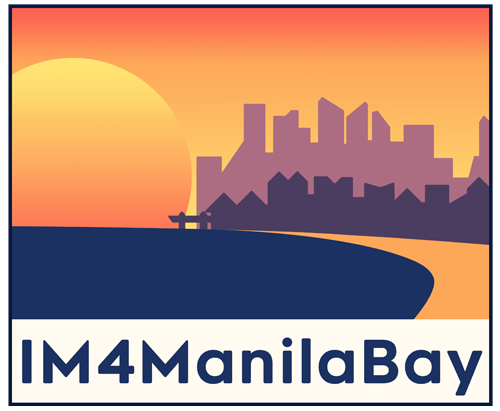Land reclamation is the process of creating new land from seas or other water bodies for the purpose of various land use. There are several reclaimed areas around Manila Bay. In Metro Manila alone, around 776 hectares of reclamation area supports several industrial and business districts such as Port of Manila, Manila Harbour Centre, SM Mall of Asia Complex, and Aseana Business Park, to name a few. In the Manila Bay Sustainable Development Master Plan of the National Economic Development Authority in September 2020, the recently approved and other proposed land reclamation projects in Manila Bay sum up to over 20,000 hectares of sea area converted to land area.
The changes in the bay’s bathymetry and coastal area brought about by land reclamation have varied effects on the coastal hydrodynamics. In Manila Bay, where current directions and flow characteristics vary depending on the season and prevailing wind conditions, the movement of water and the way it transports materials will be affected. Subsequently, the hydrodynamics or the movement of water highly affects the water quality conditions within the bay.




Residual current is the result of averaging currents in a tidal cycle (https://bit.ly/ResidualFlows). Based on the simulation, residual currents are generally slower and lead to lower bay flushing out capacity during the dry season than during the wet season for both with- and without-reclamation scenarios.
Shown in the figures are the differences in residual flow vectors between with- and without-reclamation scenarios for the dry and wet seasons. Areas with shorter arrows signify minimal effect in the flows in these areas, while those with longer arrows mean that there is a significant change in the flow’s magnitude or direction or both due to the presence of reclaimed areas.
For the dry season, the counter-clockwise movement pattern remains at the center of the bay. The slight westward shift of the gyre coincides with the increased southwestward flow near the outlet of Pasig River in the East. Most of the changes in flows can be observed near and adjacent to the reclamation sites.
For the wet season, the clockwise circulation in the bay remains the same after reclamation. Areas near Pampanga River experienced a significant increase in flushing-out flow velocities. The simulation results also show an increase in flows along the constrictions in between reclamation sites. While both with- and without-reclamation scenarios show faster flushing of materials during the wet season as compared to their dry season counterparts, the difference in their flow vectors demonstrates that it takes a longer time to flush out materials in the bay with the constrictions brought about by the coastal development. Most of the difference vectors (flow vectors after subtracting residual flows in without-reclamation from that in with-reclamation scenarios) point to the east and the north, indicating a reduction in the southwestward vector components of the flows that discharges out of Manila bay. Overall, there is a significant change in residual flows near the reclamation sites. Near Bulacan and Pampanga, longshore currents are formed at the side of the reclamation sites facing the bay.
The currents behind reclamation areas became slower after incorporating the developments in the simulations. This is reflected by the flow vectors pointing towards the shore at the north, behind the reclamation sites, as observed in the dry and wet season plots. The presence of reclamation sites also affected the tide levels at the side facing the shore, effectively lowering the tidal range (i.e. high tides became lower and low tides became higher). These changes indicate longer stagnation of water coming from the watersheds and lower exchanges with the outer sea. The resulting lower flushing characteristics of the bay for the with-reclamation scenario can have important implications on the water quality dynamics of Manila Bay
Single particle tracking simulation will help us understand how material transport can be affected by land reclamation. Several simulations with varying particle release times (wet and dry season) and locations (Manila, Pampanga River, Bacoor Bay, Pampanga Bay, Meycauayan) were performed to track the path a particle takes during the wet and dry season.
Based on the simulation results, the particle’s path, direction, and the duration of its stay in the bay before getting flushed out (i.e. residence time) change with the presence of reclamation areas. Simulations with a particle leaving the five different locations during the wet season show that the particle will take a longer time to exit Manila Bay when the reclamation sites are present. During the dry season, the residence time of a particle generally increases, although some scenarios with release points in Bacoor Bay and Meycauayan resulted in a shorter track.
When a particle was released at the outlet of Pampanga River during the dry season, it went through behind the reclamation area at its West before entering Manila Bay instead of directly passing through the constriction in front of the Pampanga River outlet. In the scenario with particle release at Bacoor Bay during the dry season, the particle moved across the center of Manila Bay in the no-reclamation setup but traversed a longer path, wider range, and longer duration while circling along the coasts of the bay, when the reclamation sites were added in the simulation. After considering the simulation results and as shown in the particle tracks, it was observed that the presence of reclamation areas tends to increase the residence time of particles within Manila Bay (i.e. longer time before materials can be flushed out). This significant finding serves as a guide in assessing proper strategies to mitigating the imminent impacts of coastal development in Manila Bay, and as a baseline information for further reclamation studies on the bay.
The model simulates the effect of reclamation during the wet and dry seasons through residual current and single-particle tracking analysis. Residual currents were computed by averaging velocities for the period of May 6-21, 2018 for the dry season and September 6-21, 2018 for the wet season, (approximately one tidal cycle). The location and areas of reclamation were identified based on the Manila Bay Sustainable Development Master Plan of the National Economic Development Authority in September 2020. The single-particle tracking was simulated using the three-layer calibrated and validated results of the hydrodynamics model. A single particle was instantaneously released at five critical locations (Pasig, Pampanga, Meycauayan, Bacoor Bay, and Pampanga Bay) near river discharge points in Manila Bay, to compare the path a particle takes on the wet and dry season for with- and without-reclamation scenarios. To follow the path of a single particle, the three-layer hydrodynamics result was coupled and truncated into one layer. All material transport simulations had a warm-up period in the beginning before a particle was introduced into the system. It is important to take note that material trapping (drag) due to the presence of natural (mangroves) or artificial (fish pens/cages) obstructions were not yet considered in the present model setup. Also, the reclamation areas were modeled using dry points, with no consideration for runup and inundation due to topographic slope.










 Room 235, National Hydraulic Research Center,
Room 235, National Hydraulic Research Center, esmart.im4manilabay@gmail.com
esmart.im4manilabay@gmail.com 

No responses yet